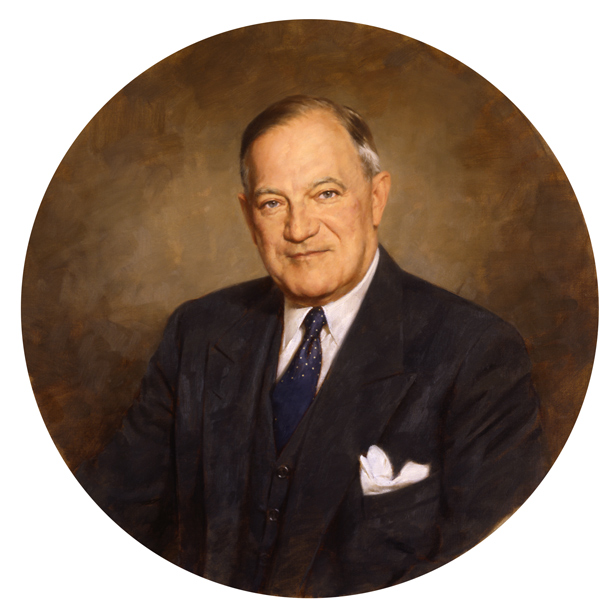
| Title | Robert F. Wagner |
| Artist/Maker | Steven Polson |
| Date | 2004 |
| Medium | Oil on canvas |
| Dimensions | h. 25.875 x w. 26.375 in. (h. 65.7225 x w. 66.9925 cm) |
| Credit Line | U.S. Senate Collection |
| Accession Number | 32.00043.000 |
In 1999 the Senate adopted S. Res. 241 directing the Senate Commission on Art to recommend two outstanding senators whose portraits would be placed in the Senate Reception Room of the U.S. Capitol. The resolution called for the selection of “legislators with a deep appreciation for the Senate, who will serve as role models for future Americans.” This was the first commission of its kind since 1957, when a special committee chaired by Senator John F. Kennedy unanimously selected five senators, today known as the “Famous Five,” whose portraits were added to the walls of the Senate Reception Room. The 1999 competition was limited to the approximately 1,500 senators whose service ended prior to 1979 and to those who were no longer living. The search focused particularly on the mid-20th century, a period in which the Senate played a significant role in both foreign and domestic policy as the nation developed into a major world power.
After careful consideration, the commission made its selection: Senator Robert F. Wagner of New York and Senator Arthur H. Vandenberg of Michigan. Their portraits, along with the “Famous Five,” occupy trompe l’oeil rondels and ornamental plaster ovals that remained unfilled after the mid-19th-century decoration of the room.
The posthumous portrait of Robert F. Wagner depicts the senator at the height of his career. His two greatest legislative achievements occurred in 1935 with the passage of the Social Security Act, providing old-age pensions to most Americans, and the National Labor Relations Act, guaranteeing workers’ rights to organize and bargain collectively. His contemporaries attributed Wagner’s legislative successes to his humanitarian progressive philosophy, his legislative skills, and his strength of conviction.
Artist Steven Polson executed the portrait in his studio, taking into consideration the scale, lighting, and historic color palette of the Senate Reception Room. He then made finishing touches to the portrait after it was installed in the rondel on the south wall, adjacent to the entrance to the Senate Chamber. Polson began his formal study in art at age 16 when he attended The Art Students’ League in New York. He earned a Fine Arts degree in 1984 from The Cooper Union for the Advancement for Sciences and Art. His work includes the official portraits of Madeleine Albright and Colin Powell for the State Department, Donald Rumsfeld for the Department of Defense, and numerous other figures in government, industry, and academia.
Senator Robert Wagner of New York (1877-1953) authored sweeping legislation that dramatically changed the American social and economic landscape. As chairman of the New York Assembly State Factory Investigation Committee from 1911 to 1915, he had investigated the tragic Triangle Shirtwaist Factory fire and other industrial hazards. These experiences sharpened his commitment to reform. Elected to the U.S. Senate in 1926, Wagner became chairman of the Senate Banking and Currency Committee during the New Deal era. Two of his most notable accomplishments were enacted into law in 1935--the Social Security Act provided old-age pensions to Americans, and the Wagner Labor Act guaranteed labor's right to organize and bargain collectively. "Whether you like his laws or deplore them," one journalist noted, "he has placed on the books legislation more important and far-reaching than any American in history since the days of the founding fathers." Senator Wagner was also a leading proponent of federal anti-lynching legislation.